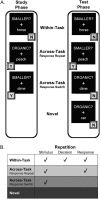Multiple forms of learning yield temporally distinct electrophysiological repetition effects
- PMID: 19915094
- PMCID: PMC2912654
- DOI: 10.1093/cercor/bhp233
Multiple forms of learning yield temporally distinct electrophysiological repetition effects
Abstract
Prior experience with a stimulus leads to multiple forms of learning that facilitate subsequent behavior (repetition priming) and neural processing (repetition suppression). Learning can occur at the level of stimulus-specific features (stimulus learning), associations between stimuli and selected decisions (stimulus-decision learning), and associations between stimuli and selected responses (stimulus-response learning). Although recent functional magnetic resonance imaging results suggest that these distinct forms of learning are associated with repetition suppression (neural priming) in dissociable regions of frontal and temporal cortex, a critical question is how these different forms of learning influence cortical response dynamics. Here, electroencephalography (EEG) measured the temporal structure of neural responses when participants classified novel and repeated stimuli, using a design that isolated the effects of distinct levels of learning. Event-related potential and spectral EEG analyses revealed electrophysiological effects due to stimulus, stimulus-decision, and stimulus-response learning, demonstrating experience-dependent cortical modulation at multiple levels of representation. Stimulus-level learning modulated cortical dynamics earlier in the temporal-processing stream relative to stimulus-decision and stimulus-response learning. These findings indicate that repeated stimulus processing, including the mapping of stimuli to decisions and actions, is influenced by stimulus-level and associative learning mechanisms that yield multiple forms of experience-dependent cortical plasticity.
Figures




Similar articles
-
Neuronal mechanisms of repetition priming in occipitotemporal cortex: spatiotemporal evidence from functional magnetic resonance imaging and electroencephalography.J Neurosci. 2005 Mar 30;25(13):3414-22. doi: 10.1523/JNEUROSCI.4107-04.2005. J Neurosci. 2005. PMID: 15800196 Free PMC article.
-
Neural priming in human frontal cortex: multiple forms of learning reduce demands on the prefrontal executive system.J Cogn Neurosci. 2009 Sep;21(9):1766-81. doi: 10.1162/jocn.2009.21132. J Cogn Neurosci. 2009. PMID: 18823245 Free PMC article.
-
Incongruent abstract stimulus-response bindings result in response interference: FMRI and EEG evidence from visual object classification priming.J Cogn Neurosci. 2012 Mar;24(3):760-73. doi: 10.1162/jocn_a_00163. Epub 2011 Nov 8. J Cogn Neurosci. 2012. PMID: 22066586 Free PMC article.
-
Electrophysiological correlates of object-repetition effects: sLORETA imaging with 64-channel EEG and individual MRI.BMC Neurosci. 2012 Oct 17;13:124. doi: 10.1186/1471-2202-13-124. BMC Neurosci. 2012. PMID: 23075055 Free PMC article.
-
Repetition and the brain: neural models of stimulus-specific effects.Trends Cogn Sci. 2006 Jan;10(1):14-23. doi: 10.1016/j.tics.2005.11.006. Trends Cogn Sci. 2006. PMID: 16321563 Review.
Cited by
-
Electrophysiological correlates of exemplar-specific processes in implicit and explicit memory.Cogn Affect Behav Neurosci. 2012 Mar;12(1):52-64. doi: 10.3758/s13415-011-0065-7. Cogn Affect Behav Neurosci. 2012. PMID: 22038704
-
The time course of activation of object shape and shape+colour representations during memory retrieval.PLoS One. 2012;7(11):e48550. doi: 10.1371/journal.pone.0048550. Epub 2012 Nov 14. PLoS One. 2012. PMID: 23155393 Free PMC article.
-
Object identification leads to a conceptual broadening of object representations in lateral prefrontal cortex.Neuropsychologia. 2015 Sep;76:62-78. doi: 10.1016/j.neuropsychologia.2014.10.041. Epub 2014 Nov 7. Neuropsychologia. 2015. PMID: 25445775 Free PMC article.
-
Repetition learning of vibrotactile temporal sequences: an fMRI study in blind and sighted individuals.Brain Res. 2012 Jan 18;1433:69-79. doi: 10.1016/j.brainres.2011.11.039. Epub 2011 Nov 28. Brain Res. 2012. PMID: 22154406 Free PMC article.
-
Repetition Priming and Repetition Suppression: A Case for Enhanced Efficiency Through Neural Synchronization.Cogn Neurosci. 2012;3(3-4):227-237. doi: 10.1080/17588928.2012.670617. Epub 2012 Mar 1. Cogn Neurosci. 2012. PMID: 23144664 Free PMC article.
References
-
- Badre D, D'Esposito M. Functional magnetic resonance imaging evidence for a hierarchical organization of the prefrontal cortex. J Cogn Neurosci. 2007;19:2082–2099. - PubMed
-
- Badre D, Poldrack RA, Pare-Blagoev EJ, Insler RZ, Wagner AD. Dissociable controlled retrieval and generalized selection mechanisms in ventrolateral prefrontal cortex. Neuron. 2005;47:907–918. - PubMed
-
- Badre D, Wagner AD. Left ventrolateral prefrontal cortex and the cognitive control of memory. Neuropsychologia. 2007;45:2883–2901. - PubMed
-
- Bentin S, Peled BS. The contribution of task-related factors to ERP repetition effects at short and long lags. Mem Cognit. 1990;18:359–366. - PubMed

